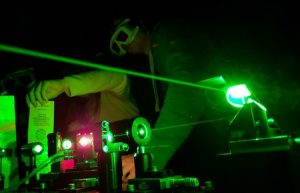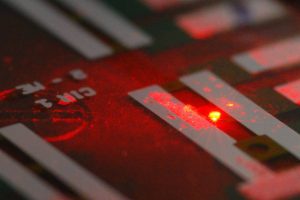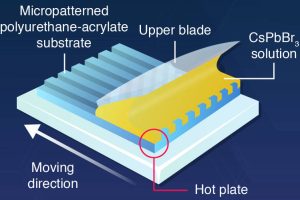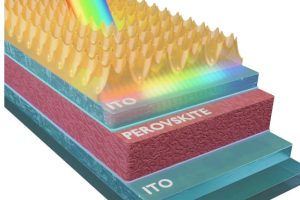
Now a team from University of Groningen in the Netherlands and Nanyang Technological University in Singapore think they have seen useful hot electron capture in action, having thought to add the organic wide bandgap compound bathophenanthroline (‘bphen’) to the perovskite CH3NH3PbI3.
According to Groningen, finding a material with the correct wide bandgap is only half the battle when trying to exploit hot electrons. The other half is that these hot electrons spontaneously loose their energy as heat in picoseconds – long before they have a chance to be rendered useful.
Researchers from several institutions have been looking for structures and materials that will slow the cooling of these fast carriers long enough for a wider bandgap material to get hold of them, and earlier research (see below) showed that CH3NH3PbI3 perovskite naturally just happens to slow that cooling – but long enough for a second semiconductor to capture that energy?
So having invented a potentially useful semiconductor mixture, the researchers were left with the question: how do you proved that a picoseconds action didn’t happen, and that the hot electron was made to do something useful in the following nanoseconds?
Which led to the second innovation: a measurement technique for their material, that will also be useful for analysing future hot-electron solar materials.
In a proof-of-principle study, the Groningen-Nanyang partnership used multiple ultra-fast laser pulses (see photo) to excite hot electrons in the perovskite, using a “realistic amount of energy, comparable to visible light”, according to the University of Groningen.
“We used a method called pump-push probing to excite electrons in two steps and study them at femtosecond timescales,” said Pshenichnikov, who is a professor of ultra-fast spectroscopy.
This produced electrons in the perovskite with energy levels just above the bandgap of bphen, without exciting electrons in the bphen – meaning that any hot electrons found in the bphen had come have come from the perovskite. It transpired that these hot electrons were readily absorbed by the bphen rather than turned to heat.
“This happened without the need to slow down these electrons and, moreover, in bulk material,” according to Pshenichnikov. “So, without any tricks, the hot electrons were harvested.”
However, the subtle measurements also revealed that the energy required was slightly higher than the bphen bandgap. “This was unexpected,” he said. “Apparently, some extra energy is needed to overcome a barrier at the interface between the two materials.”
Overall, the perovskite-bphen combination has the potential to extract more energy from sunlight than plain perovskite, but not as much additional energy as would be harvested if the newly-discovered barrier could be overcome.
“Our findings show how hot these charges have to be, in order to cross over the energy barrier without being wasted as heat,” said Professor Sum Tze Chien of Nanyang. “This highlights the need for better pairing of extraction materials with perovskites if we want to lower this energy barrier for more efficient solar cells.”
It was Sum and his collaborators that earlier discovered that perovskite semiconductors naturally slow the waste of hot carrier energy – and his group also showed that this energy loss can be further slowed by using nano-sized perovskite materials.
The Groningen-Nanyang team is now planning to create a complete solar cell using a hot carrier material combination.
The work is published as ‘Hot carrier extraction in CH3NH3PbI3 unveiled by pump-push-probe spectroscopy‘ in Science Advances.
The full paper is available free, and is clearly and well written. It is well worth a browse for those interested in the behaviour of hot carriers in semiconductor lattices – the mechanism for high-speed wastage of hot carriers is discussed in detail, starting with carrier-carrier or carrier–optical phonon scattering.
Photo: Ultra-fast spectroscopy at the University of Groningen, by Maxim Pshenichnikov, who was a visiting professor at Nanyang Technological University for the past three years.
 Electronics Weekly Electronics Design & Components Tech News
Electronics Weekly Electronics Design & Components Tech News



